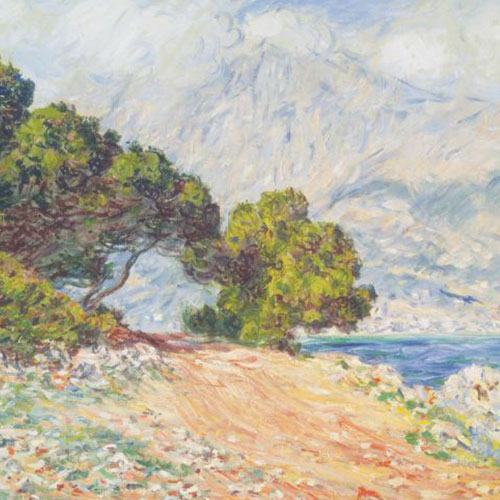FEATURED ARTS
Learn About Impressionism Through Monet Paintings at the Currier
Written By Kelly Sennott (ksennott@hippopress.com)
Images: Courtesy Photo
The latest Currier Museum of Art show features a quick art history lesson on impressionism, illustrated by the guy who started it all.

“Monet: Pathways to Impressionism,” on view July 1 through Nov. 13, showcases the museum’s own “The Bridge at Bougival” (1869), plus three other major paintings by Claude Monet borrowed from the Kimball Art Museum in Texas and the Museum of Fine Arts in Boston: “La Pointe de la Hève at Low Tide” (1865), “Cap Martin” (1884) and “Charing Cross Bridge” (1900). In another room are American paintings from the Currier’s collection inspired by Monet.
Monet inadvertently created the term with his 1874 painting, “Impressionism, Sunrise,” which critics attacked at the time because it seemed hazy and without form and structure. Monet insisted that’s what he was going for; it was his “impression” of that particular place. He and other artists of the period adapted the term for their movement.
“At the time, you [had] realism, and this is a direct response against realism,” said curator Kurt Sundstrom during a gallery walk-through. “People change so slowly. It’s like when Picasso [introduced] cubism. People said, ‘What the heck is that?’ It’s just too much of a change.”
The 19th-century movement is characterized by small but visible brush strokes, unusual visual angles and emphasis on accurate depiction of light, all of which help shape the artist’s perception. Each of the paintings on view in the show represents a period in the artist’s career and his movement toward this style.
The oldest, “La Pointe de la Hève at Low Tide,” was Monet’s first in the Salon, an important Parisian art exhibition. It depicts a rocky, coastal scene on a cloudy day. Monet was just 24 when he painted it.
“This caused a sensation,” Sundstrom said. “It’s still realist in the same way that you paint what you see. But what he did is he came out to this beach, sketched … and then took the sketches back to his studio, put the best elements together and constructed a scene.”
Monet painted the museum’s own “The Bridge at Bougival” four years before he painted with full-blown impressionist style, but you can see him moving toward that idea. Rough brush strokes suggest rippling water, and a dash becomes a chimney in this picturesque village scene.
“The teeny, tiny definitions done up, characteristic of realism, are gone,” Sundstrom said. “It was about capturing the moment. He’s using his artistic license to move things around. You can see his brush strokes are getting heavy and thick here to capture that sense of reflection of light. But what he’s also doing is using it as a way to suggest depth into space.”
In the last two images, buildings and figures disappear. “Cap Martin,” another seashore scene, contains swirling trees, suggesting a seabreeze, and “Charing Cross Bridge” depicts a London train scene on a smoggy, foggy day.
“You don’t see the trains at all, but you see the smoke coming off and the light passing through that smoke and turning purple,” Sundstrom said. “It’s not just impressionism. He’s trying to capture an emotional response.”
It wasn’t easy getting all these Monet paintings in place, but Sundstrom hopes the result helps better tell the story of impressionism and why the museum’s piece is so significant.
“People don’t want to lend out their Monets,” Sundstrom said. “We only have one here, and it’s a really important Monet because it’s transitional. Ours [was painted] four years before the term ‘impressionism’ was coined. And at the same time, our Monet is probably one that bridges the gap more clearly than any other Monet, from his early realist style to full-blown impressionism.”
Monet: Pathways to Impressionism
Where: Currier Museum of Art, 150 Ash St., Manchester
When: On view July 1 through Nov. 13
Admission: $15 for adults, $13 for seniors, $10 for students, $5 for youth ages 13 to 17, free for children younger than 13
Contact: 669-6144, currier.org
Related Events
Both are free with museum admission.
• Storytime in the Gallery Monday, July 24, at 11:30 a.m., reading of Philippe in Monet’s Garden by Lisa Jobe Carmack, followed by craft where listeners can create their own garden inspired by a work of art, for ages 2 to 5
• Focus Tour of “Monet: Pathways to Impressionism” Saturday, Aug. 26, at 11:30 a.m., led by a museum docent educator
Twilight at the Currier: Summer Block Party
The inaugural Summer Block Party is at the Currier Museum of Art Saturday, July 22, from 5 to 9 p.m. Admission is free. There will be photo booths, live music, henna tattoo artists, a live band and local art organizations sharing their art. Dimensions in Dance performs a piece inspired by the Currier’s outdoor Mark di Suvero sculpture, and Positive Street Art conducts a community mural project visitors are welcome to participate in and organizes a live art competition (four artists create art within 90 minutes). In addition, there will be food trucks, a beer and wine tent, chalk art, a performance by Dream City Dance in Vermont, plus a puppet performance courtesy of Art Center students. “We really want people to come to the event and see everything the Currier has to offer, for its wonderful art collection and exhibitions, and as a fun place to come to,” said Lynn Thomson, who’s organizing the event. “The last couple of years [we’ve been] reaching out more to the community and making sure people are aware of us being here. … We see this as another step in that direction.”
